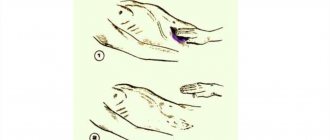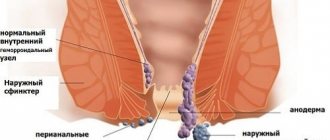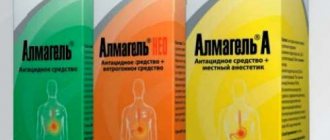Mayo-Robson sign for pancreatitis
In a world of speed, stress and fast food, the human body has a hard time.
Experiencing colossal stress, the body often malfunctions and serious diseases are discovered that, if desired, could have been avoided. For example, pancreatitis, a common disease of the 21st century, appears mainly due to the fault of the person himself. Includes inflammation of the pancreas tissue, manifested by sharp and aching pain, bowel dysfunction, weight loss and vomiting. It often occurs due to poor nutrition, alcohol intoxication, and the consequences of previous infections and injuries. The pancreas is involved in the process of food digestion and the endocrine system; failure of the organ has a negative impact on the human body. There are acute and chronic forms of pancreatitis. For any manifestation of the disease, appropriate treatment is prescribed in combination with antibiotics, a strict diet, and in severe stages, surgical intervention is possible. Treatment and recovery are carried out under the strict supervision of the attending physician. Self-medication of pancreatitis is unacceptable.
Diagnosis of the disease
Based on general signs of malaise, it is impossible to immediately make a diagnosis and say that pancreatitis is certainly present. In addition to the form of the disease, several types of pancreatitis with various complications are known. A thorough examination is carried out to make a diagnosis. It will be necessary to take tests, conduct an ultrasound examination and a full examination of the patient.
The examination is carried out by palpation according to the established methodology. The method is based on a person’s feeling of pain in certain places during palpation and percussion of the area under study; each case is characterized by special symptoms. Symptoms of pancreatitis are named after the authors, named after the doctors who studied these symptoms: Kerte's symptom, Mayo-Robson, Voskresensky, Kach, Razdolsky, Mondor.
The principle of palpation for pancreatitis
This method has been used since the mid-20th century, when it was not possible to use special equipment for diagnostics; doctors trusted their fingers during examination. And now palpation and percussion are included in the research complex for making a diagnosis.
In a healthy person, the pancreas cannot be palpated. The only thing that will help is excellent knowledge of the anatomical structure of the human body. You can feel the pulsation of the aorta on the anterior abdominal wall during examination, a large vascular trunk lying on the spine. When palpating and percussing the pancreas, it is necessary to observe changes in the nature of the patient's pain.
How does the examination take place?
An increase in the size of the pancreas indicates an inflammatory process. To make a correct diagnosis, palpation is performed. It is done in the morning on an empty stomach or after cleansing the intestines with an enema. The patient lies on his back. The doctor's task is to find the lower part of the stomach. Using the fingers of your left hand, you feel the skin on your stomach somewhere 2-3 cm further than the lower part of the stomach, and at the same time move it. Then, when the press relaxes, which occurs when exhaling, the fingers are immersed all the way to the rear abdominal wall. Without tearing them off, stroke the skin from top to bottom. A qualified doctor can immediately notice an enlarged pancreas.
It is worth noting that it is very difficult to palpate the pancreas in a healthy person. Palpation helps to make an accurate diagnosis, only with pancreatitis this area, where the Mayo-Robson point is located, hurts greatly. At the initial stage of the disease, an enlarged pancreas can be seen visually. In the chronic form of pancreatitis, it gradually decreases. Therefore, in addition to the examination, it is necessary to conduct a full examination. This means taking tests, x-rays or ultrasound.
Sources
- https://NogoStop.ru/zhivot/simptom-mejo-robsona.html
- https://ProZKT.ru/metody-diagnostiki/simptom-mejo-robsona.html
- https://gastri.ru/simptom-mejo-robsona.html
- https://ZhivotNeBoli.ru/simptomy-i-sindromy/simptom-mejo-robsona-pri-pankreatite.html
- https://www.syl.ru/article/467384/zona-shoffara-gde-nahoditsya-prichinyi-boleznennosti-palpatsiya
- https://GastroTract.ru/bolezn/pankcreatit/simptom-mejo-robsona-pri-pankreatite.html
- https://fb.ru/article/254740/tochka-meyo-robsona-zonyi-podjeludochnoy-jelezyi
Signs of pancreatitis by author
The characteristic signs reveal how advanced the disease is and determine the form of its course. Let's take a closer look briefly.
- Mondor's sign. The sign is characteristic of acute pancreatitis. It appears in the form of dark blue spots on the skin, and the spots are located throughout the human body, even on the face. Bruises are accompanied by severe abdominal pain. This happens due to the release of toxins by the gland, initially into the blood, then into the thickness of the skin. Dark spots on the face indicate the appearance of intoxication and the severity of the disease, when surgical intervention is required.
- Razdolsky's symptom. The sign reveals acute pancreatitis with obvious inflammation of the peritoneum. When you tap your fingers on the skin in the area where the gland is projected, the patient will feel a sharp pain. The symptom is explained by the irritating effect of fingers on the inflamed peritoneum. At a mild stage of the disease, the syndrome may not appear.
- Voskresensky's symptom. Used to identify the diagnosis of acute pancreatitis. The point is in the characteristic feature: during examination, pulsation of the abdominal aorta zone at the intersection with the pancreas will not be felt. This point will be located approximately 5 cm above the navel, moving towards the gallbladder by 3-4 cm. It is enough to move it with a light, smooth movement along the stretched tissue from the epigastric area towards the liver. The beat will not be palpable. Occurs due to swelling of the gland that occurs during inflammation. A thickening appears in the peritoneum through which the pulse cannot be felt. The method is not suitable for people with large body weight; the fat layer does not allow proper palpation.
- Kach's symptom. Characteristic of chronic pancreatitis. When palpating the projection of the tail of the organ, obvious painful sensations will appear, making it impossible to continue the examination. The Kacha point is located in the area of the transverse process of the eighth thoracic vertebra. Signs of skin sensitivity may appear in the indicated area.
- Kerte's sign. Characteristic for confirmation of acute pancreatitis. It is explained by the occurrence of tension in the muscles of the anterior abdominal wall, the appearance of pain when palpating with fingers in the area of the left hypochondrium, 5 cm above the navel. Actions occur due to the protective properties of the body in an attempt to hide the organ under tense tissue in the area of inflammation. This is a fairly common symptom.
- Mayo-Robson sign. Let's consider the method in more detail.
Mayo-Robson sign
A similar symptom appears in acute pancreatitis, during an attack, but is not detected in every patient. The symptom is detected in the form of sharp pain when you press the Mayo-Robson point, its position is detected in a certain way:
- the point is located in the projection of the body and tail of the pancreas;
- visually draw a line from the navel up to the center of the lower rib on the left side;
- the source of pain is localized in the middle third of the drawn line.
If the tail of the pancreas is affected, pain will appear in the front or back of the body; in other cases, the method does not work.
This nominal syndrome was studied in detail and scientifically substantiated by the English surgeon Arthur William Mayo-Robson at the beginning of the 20th century. In addition to the symptom, the doctor studied many topics related to diseases of the internal organs, which became the basis of the treatment method.
The article lists the author's main signs of pancreatitis. Additional symptoms of the disease are also known. As a rule, the detection of at least two symptoms during examination becomes the basis for admitting the patient to the hospital and carrying out appropriate treatment.
Other techniques
In addition to the Mayo Robson symptom, in pancreatitis, other manifestations are used to diagnose the disease. Let's take a closer look at them.
Mondor syndrome: bruises of varying sizes and locations appear on the body of a patient with an acute disease. Bruises can even occur on the skin of the face. Their appearance is explained by the fact that when the pancreas becomes inflamed, toxins are released into the blood and then into the dermal layers. In this case, the person feels severe pain in the abdomen.
Kach's symptom: allows you to determine the presence of chronic pancreatitis. When you press on the Kacha point, which is located in the area of the 8th thoracic vertebra, painful sensations appear. The pain may be so severe that the patient does not allow the doctor to carry out further examination.
Razdolsky syndrome: manifestations are observed in the severe stage of the disease, when inflammation of the peritoneum occurs. If the pathological process is mild, the method may not be informative. It manifests itself as sharp pain in the abdomen when tapping the skin in the area of the inflamed gland with your fingertips.
Find out what salads you can prepare for pancreatitis.
Read: what features does Diet 5 have for pancreatitis?
Kerthe syndrome: the patient feels severe pain when palpating the abdomen in an area located 5 centimeters above the navel. The symptom is observed in approximately 6 out of 10 patients with acute pancreatitis.
All of the above signs can be used by a gastroenterologist as auxiliary tools in diagnosing the disease. Their use does not require the presence and use of special equipment and reagents, and is available to any doctor in any medical institution.
Main signs of pathology
With the Mayo-Robson symptom, pain is felt at a point located in the pancreas itself. Such a point is located on the left side in the corner of the costovertebral view. Unpleasant sensations, and then severe pain, begin with inflammatory processes in the pancreas.
As for the anatomical topographical basis, the gland is usually located approximately at the level of the first lumbar vertebra. The longitudinal axis is located at an oblique angle from bottom to top and from right to left.
In the maximum right position, the head of the organ can be located 70 mm closer to the outer side of the spine. At this time, the tail extends approximately 30 mm into the left area of the spine. The body of the gland does not extend, but is completely superimposed on this contour.
In the maximum left position, the head of the gland is located opposite the spine, but the tail and body of the organ can be located approximately at a distance of approximately 90 mm from the left side of the spine.
Other known manifestations
In addition, there are other nominal symptoms. For example, with Kerthe syndrome, discomfort, pain and resistance manifest themselves upon palpation in the anterior abdominal wall. The point is located approximately 50 mm higher than the navel. Most often, this symptom manifests itself in the acute form of pancreatitis in 60% of all patients with this disease.
Kach's symptom is another nominal syndrome for pancreatitis. It can be detected by palpation in the area between the 8th and 11th thoracic vertebrae, specifically their processes in the transverse plane. Typically, this syndrome manifests itself in the chronic form of the disease. If the patient has a parenchymal form of pancreatitis, then such a symptom will also consist of hyperesthesia of the skin. In other words, not only does a person feel internal pain in the body when this area is pressed, but the skin also becomes overly sensitive. Moreover, such changes usually spread in the area of the eighth segment of the thoracic spine on the left side.
Voskresensky's symptom is another author's sign of inflammatory processes in the pancreas. It lies in the fact that pulsation insensitivity is detected in the area of the abdominal aorta at the point where it intersects with the pancreas. In fact, these are false sensations. This place can be felt if you rise 50 mm higher than the navel, and then 40 mm further to the left. This syndrome manifests itself due to infiltration of the space behind the peritoneum. If this symptom occurs, it means that the patient has an acute form of pancreatitis. It is quite simple to identify it - you just need to run your palm over your stomach.
In addition, there is Mondor's symptom. It is also characteristic of the acute form of the disease. This syndrome manifests itself as cyanotic spots. They have a blue tint and spread over the patient's body and face. The appearance of such spots is associated with severe intoxication of the entire human body.
Razdolsky's symptom is also distinguished. It also occurs only in acute forms of the disease. This syndrome is expressed in the form of sharp and acute painful sensations upon percussion over the area where the pancreas is located. This syndrome manifests itself due to shaking of the inflamed peritoneum.
Therapeutic measures
It is not possible to get rid of specific symptoms, including Mayo-Robson syndrome, individually. Complex treatment of pancreatitis is required. First of all, it is necessary to begin therapy for the acute form of the disease with conservative therapy. It is usually used for mild cases of the disease, when the patient has an edematous form of pancreatitis. Also, such therapy helps with the sterile type of pancreatic necrosis.
From the first days, in severe cases of pancreatitis, antibiotics are prescribed. It is necessary to choose a group of drugs with a wide spectrum of action. In addition, they are also used to prevent septic and purulent processes. Contrical is administered to inhibit proteolytic enzymes that circulate in the blood. If the intoxication of the body is pronounced, then hemosorption and plasmapheresis are required - these are methods of purifying the blood outside the kidneys. To prevent the occurrence of disseminated blood coagulation inside the vessels, Heparin is prescribed. It is better to choose its analogues with a low molecular structure. Infusion therapy plays an important role. It replenishes the lack of blood, and also removes harmful substances from the body and improves blood circulation at the micro level. All medications and procedures are prescribed only by a doctor.
Under no circumstances should you try to eliminate the manifestations of the Mayo-Robson symptom and other signs of pancreatitis on your own.
Surgery is required when serious complications develop. For example, septic and purulent, hemorrhagic and arrosive, mechanical jaundice. The same applies to cholecystitis of a destructive nature, various necrosis of an uninfected type. It is necessary to take into account the presence of cysts of a false nature.
You definitely need to stick to your diet. It is very tough, but effective. Thanks to the constant implementation of her rules, pain, including the author’s symptoms, will not appear. Nutrition should be gentle to reduce the load on the stomach and pancreas. It is best to eat vegetables stewed and boiled. Baked apples are useful fruits. Jam and honey are allowed, but no more than 1-2 spoons per day. Vegetarian vegetable and milk-cereal soups are very healthy. Milk porridge is also allowed. You can eat poultry, fish and meat, but they should not be fatty. Cottage cheese casseroles and steamed omelettes are healthy. For sweets, marmalade, biscuits, and marshmallows are allowed, but not much.
You will have to give up sour-tasting vegetables, fruits, herbs and berries. All spices and seasonings are prohibited. You cannot eat nuts, legumes and mushrooms. Coffee, chocolate, cocoa, baked goods, brown bread, kvass and carbonated drinks are strictly prohibited. You will have to give up sausages, smoked meats, marinades, sausages, and pickles. You should not eat foods that are spicy or sour to taste, as well as anything fatty or fried.
Pancreatitis is a serious inflammatory disease of the pancreas. It can occur in both acute and chronic forms. When the disease occurs, various symptoms appear, some of which have become named in medicine. The most common symptom in patients with this disease is Mayo-Robson syndrome, when a certain point is felt with severe pain. Treatment is the same as for pancreatitis: medications, procedures, diet and surgery in severe cases. Be healthy!
What are the symptoms of pancreatitis?
Given the symptoms, ambulance workers often confuse pancreatitis with poisoning, gastritis and appendicitis. After delivering the patient to the hospital, taking a more thorough history and conducting tests, the doctor determines pancreatitis.
To make an accurate diagnosis, the following methods of examining the patient are carried out:
- Anamnesis collection. The doctor finds out where, how, when the pain began, and whether there is a disturbance in general health.
- Visual inspection. The condition of the skin is assessed and the patient's tongue is examined.
- Analysis of the patient’s general condition: measurement of body temperature and blood pressure, palpation, auscultation and percussion. In this case, various methods are used - symptoms. Mayo-Robson, Razdolsky, etc.).
- Laboratory - general and biochemical blood tests, assessment of water and electrolyte balance in the blood, general urine analysis.
- Instrumental - ultrasound, X-ray examination, computed tomography, FGDS, laparoscopy.
Diagnosis of pancreatic lesions
In addition to confirming the symptoms from the patient’s words, palpating points and zones, it is necessary to take a biochemical blood test and assess the water and electrolyte balance. A urine test is required. To confirm the diagnosis, instrumental methods are needed to help examine the organ and identify pathological processes. An ultrasound examination is prescribed. To exclude the formation of stones, they are sent for an x-ray. Computed tomography and endoscopy help to provide an extensive analysis of the disease picture. It is important to start treatment in a timely manner.
Symptoms of pancreatic inflammation by authors
The doctor also determines the symptoms of pancreatitis according to the authors. A thorough examination of the patient in the initial stages helps to avoid invasive (penetrating) tests.
The main symptoms of acute pancreatitis during an objective examination include several techniques. Among them:
- Voskresensky's symptom, also called the “shirt” symptom. The doctor makes a sliding movement from top to bottom towards the projection area of the pancreas as the patient exhales. At the end of the movement, the patient notes increased pain in this area. The sign is positive. The “shirt” symptom is also determined in acute appendicitis, so you cannot rely on this method alone.
- Mayo-Robson sign for pancreatitis. On the left in the costovertebral angle or in the area above the pancreas, the patient notes severe pain. The doctor palpates the Mayo-Robson point, pressing lightly on it. In this case, the person notices increased pain.
- Shchetkin-Blumberg symptom. The doctor slowly presses his hand on the patient's abdominal wall and sharply removes it. The consequence is sharp pain in the affected area caused by irritation of the peritoneum.
- Kerte's sign. Increased pain and muscle tension during superficial palpation in the area above the navel (about 4-5 fingers) along the midline of the abdomen.
- Razdolsky's sign. While tapping over the inflamed gland, the patient notices increased pain. This is due to peritonitis. Razdolsky's sign is positive in acute pancreatitis.
- Sign of Kach. When trying to palpate the area of the tail of the pancreas, the patient experiences severe pain. More often the symptom is positive during an exacerbation of chronic pancreatitis.
If emergency medical personnel detect one of the above signs and symptoms, the patient should be immediately hospitalized in a hospital to confirm the diagnosis and further treatment.
There are also additional signs of pancreatitis. The most commonly used symptoms in practice are the following:
- Cullen - characterized by the appearance of cyanosis in the patient's navel. This indicates the “impregnation” of nearby tissues with the decay products of the inflamed gland.
- Mondora - is characterized by the fact that the patient, together with abdominal pain, vomiting and signs of irritation of the abdominal wall, has cyanosis of the face, and spots of blue and purple colors appear on the body. This indicates that the breakdown products of the gland enter the bloodstream and, as a result, more distant tissues are affected.
- Lagerlef - provokes general cyanosis of the face and limbs.
- Tuzhilina - during the initial examination, the presence of angiomas on the face (proliferation of blood vessels under the skin) is noted. The presence of subcutaneous purple spots with a diameter of up to 5 mm is visually determined.
- Güllen - manifests itself in the fact that the patient develops jaundice in the navel area.
- Grotta - characterized by hypotrophic changes in the area of projection of the inflamed gland.
- Georgievsky-Mussi - a person experiences a sharp sharp pain in the right hypochondrium when pressing a finger into the fossa of the sternocleidomastoid muscle. This is due to irradiation along the nerve branches of the diaphragm.
- Desjardins - when pressing on the area located 4-6 cm from the navel towards the armpit (at Desjardins' point), pain is determined. This symptom in 75% of cases is positive for inflammation of the pancreas.
- Gubergritsa-Skulsky - pain on palpation in the projection of the line connecting the tail part with the head of the pancreas.
- Shoffara - increased pain in the projection of the head of the inflamed gland (Shoffara area) when pressed.
If most of the symptoms are confirmed, then additional laboratory and instrumental non-invasive examination is carried out. If necessary, deeper penetration testing is prescribed. In such cases, once the diagnosis is confirmed, surgical treatment is performed. If there was no invasive intervention, then further treatment tactics depend on the severity of the disease.
The structure of the pancreas
This large organ is located on the back wall of the abdomen behind the stomach. It consists of three branches:
- The head is hook-shaped.
- The body is similar to a prism, separated from the head by grooves.
- The tail of the pancreas, the end of the body, is slightly curved upward.
The pancreas occupies an important place in ensuring the vital functions of the body, and is also responsible for performing external and internal secretory activities. When it is damaged and there is an inflammatory process, a disease such as pancreatitis occurs. In appearance it can be acute or chronic. Inflammation of the pancreas can cause other diseases.
Patients often experience pain on the left side under the ribs. Other signs of pancreatic disease may appear after some time. This is sudden weight loss, loss of appetite, vomiting, diarrhea. The patient may not be aware of the inflammatory process. Therefore, if you experience periodic pain on the left side under the ribs, you should contact a medical facility to find out its cause. Damage to the pancreas can lead to serious consequences.
Chronic pancreatitis syndromes
Pain syndrome.
Localization: most often in the left hypochondrium, epigastrium, right hypochondrium, often the pain has a girdling nature with irradiation to the back, less often in the navel area with irradiation to the groin area, thigh.
Character: pressing, burning, drilling, bursting, usually deep.
Duration: constant painful or paroxysmal with mild self-limiting attacks lasting 1-3 days or rare long ones. Hunger pain and night pain are possible.
The pain is relieved by sitting with a slight bend forward, in the knee-elbow position, and worsened by lying on your back, after eating.
Pain is provoked by eating fatty, spicy, sour, sweet, hot or cold foods, vegetables and fruits, and alcohol. After drinking alcohol, the pain may intensify or appear after several hours or days.
Gastric dyspepsia syndrome
– Anorexia (usually persistent)
– Vomiting (usually not bringing relief, profuse, repeated)
– Feeling of early satiety
– Feeling of “fullness” in the stomach after eating
Biliary hypertension syndrome
(jaundice, itchy skin, dark urine, discolored stool). It occurs in the pseudotumor form of CP or due to pressure from the proliferating head of the pancreas on the distal part of the common bile duct.
Exocrine insufficiency syndrome
- Unstable stool with a tendency to diarrhea, mushy, sticky, shiny in appearance, with undigested food.
– Loss of body weight.
– Steatorrhea (excretion of more than 5 g of neutral fat per day with feces).
– Creatorrhea (the presence in the stool of muscle fibers with a striated pattern and sharp ends).
– Deficiency of fat-soluble vitamins K, A, D, E (rare).
– Vit deficiency. B12 (result of malabsorption).
Intrasecretory insufficiency syndrome
(pancreatogenic diabetes mellitus)
In addition, it is possible:
– Inflammatory syndrome (increased temperature from low-grade to febrile, laboratory markers of inflammation.
– Cardiovascular disorders (tachycardia, arrhythmias, hypotension, cardialgia).
Symptoms of chronic pancreatitis
Manifestations of chronic pancreatitis depend on the severity of the course and the frequency of exacerbations. Usually the disease worsens with dietary violations. Thus, patients usually associate the deterioration of their condition with consumption of fatty foods or alcohol. During exacerbation of pancreatic diseases, the main symptoms are:
- abdominal pain,
- dyspepsia (digestive disorders),
- general manifestations.
The pain in chronic pancreatitis is aching, dull, but in severe cases it can be very intense. It is localized mainly in the epigastric region, in the right or left hypochondrium - depending on which part of the organ is affected (head, body or tail of the gland).
In cases of severe inflammation, the pain spreads to the back, under the left shoulder blade, and may have a girdling character. With exacerbation of inflammation of the pancreas, a specific sign is the Mayo-Robson symptom, when pain intensifies with pressure in the area of the left vertebral-costal angle.
Important: if such pain occurs, you should immediately consult a doctor.
With chronic inflammation, digestive processes are disrupted, which is associated with insufficiency of the excretory function of the pancreas. Most substances that come from food are digested and absorbed in the small intestine. A deficiency of pancreatic enzymes means that carbohydrates, fats and proteins cannot be fully absorbed. Therefore, phenomena such as bloating, diarrhea, and changes in stool occur.
The stools become liquid and profuse (polyfeces). The stool has an oily consistency and an unpleasant smell of rancid oil. Sometimes you can visually notice drops of fat and undigested food residues in it. Other complaints include nausea, belching, sometimes vomiting, and dry mouth. As a result of insufficient breakdown of nutrients, patients may lose weight.
In chronic pancreatitis, the functional cells of the pancreas are destroyed, and enzymes from them enter the blood. These substances have an irritating and toxic effect on other organs and tissues of the body. Therefore, when inflammation of the pancreas worsens, the following symptoms may appear:
- headache;
- heart rhythm disturbances;
- temperature increase;
- general weakness, etc.
A general blood test can detect an increase in ESR, leukocyte levels and a neutrophil shift towards younger forms. With a progressive course, diabetes mellitus often develops due to insufficient insulin synthesis. Additional information about the manifestations, causes and treatment of exacerbation of chronic pancreatitis can be found in the video at the end of the article.
Objective symptoms of pancreatitis
1. Pain on palpation according to Grogt and Mayo-Robson in the projection of the pancreas (if the head is affected at the Desjardins point and Choffard zone, if the tail is affected - at the point and Mayo-Robson zone, if the body is affected - in the Gubergrits-Skulsky zone - along the line connecting the head and tail).
2. Pain at the Desjardins point (pancreatic point) - 4-6 cm from the navel along the line connecting the navel to the right armpit.
3. Pain in the Choffard area (projection of the head of the pancreas (PG).
4. Soreness at the Mayo-Robson point (the point of the tail of the pancreas) – the border of the middle and outer third of the line connecting the navel with the left costal arch as it continues into the left axillary region.
5. Pain in the Mayo-Robson area (left costovertebral angle).
6. Grotta’s symptom – hypo- and atrophy of subcutaneous fat to the left of the navel in the projection of the pancreas.
7. Positive left-sided phrenicus symptom (Mussy-Georgievsky symptom).
8. A positive Voskresensky symptom is the absence of pulsation of the abdominal aorta in the projection of the pancreas.
9. Tuzhilin’s symptom is the presence of crimson (dark burgundy) color of hemorrhagic droplets measuring from 1-2 to 4 mm, which are a kind of angiomas, as a result of proteolysis during exacerbation of chronic pancreatitis (CP).
10. Pain in the Kach area - in the projection of the transverse processes of the vertebrae on the right TIX-TXI, and on the left - in the area TVIII-TIX.
Common symptoms of pancreatitis
Pancreatitis is a disease that results in inflammation of the pancreas. The cause of pancreatic disease may be hereditary predisposition, alcohol abuse, pathologies of the digestive system, chronic diseases, poor diet and other negative factors.
Characteristic symptoms are:
- Yellowing of the skin and sclera.
- Pallor of the complexion, which later gives way to a so-called sallow tone.
- Sunken eyes.
- The appearance of bloody marks in the groin and abdomen.
- Plaque on the tongue.
- Smell of acetone in the mouth.
- Dyspnea.
- Increased heart rate.
- Pain sensations radiating to the left side and lower back.
- Dyspeptic disorders.
Not everyone knows about the Mayo-Robson symptom. This phenomenon is observed only in people who suffer from pancreatitis or other serious diseases of the pancreas. Pancreatitis is a serious disease in which certain specific symptoms in medicine are named. The most famous are the syndromes of Mayo-Robson, Kutch, Kerte, Mondor, etc. By their presence in a patient, one can determine the degree of development of the disease and its form.
Mechanism of disease development
Pancreatitis is a malfunction of the pancreatic juice produced by the pancreas. The juice contains enzymes necessary to break down complex elements (fat, protein, carbohydrates). If food entering the intestines is not processed properly, indigestion, stool disorders, and exhaustion of the body due to nutritional deficiency occur.
A lack of supply of pancreatic enzymes most often occurs due to obstruction of the duct. This can happen as a result of damage to the organ or the presence of stones blocking the flow of juice.
Pancreatic juice trapped inside the pancreas corrodes the tissue of the pancreas itself. The organ becomes inflamed, and the outflow of pancreatic juice becomes even more difficult. In addition, necrosis (death of damaged cells) causes the appearance of pseudocysts, tumor formations, and replacement of parenchyma cells with fat or connective tissue.
The mechanism described above develops against the background of the underlying causes:
- the presence of cholelithiasis, diabetes or other chronic ailments;
- infection by infections, fungi, viruses;
- hormonal disorders;
- receiving physical injuries in the abdominal area.
The most common scenario for the development of pancreatitis occurs due to an unhealthy lifestyle: fatty foods, alcohol, lack of exercise, permanent stress, lack of sleep, overwork.
The mechanism of development of signs of inflammation of the pancreas
The causes and signs of inflammation of the pancreas are closely related. After all, symptoms appear only after exposure to a provoking factor (alcohol, fatty foods). It is worth knowing that acute and chronic pancreatitis are very different from each other. In the first case, the mechanism for the development of pathology is self-digestion of the pancreas. In healthy people, pancreatic enzymes are secreted in an inactive state. They begin to break down proteins, fats and carbohydrates only after reaching the stomach. There, activation of pancreatic enzymes occurs. In acute pancreatitis, this process starts earlier, that is, in the gland itself. Under the influence of enzymes, in particular lipase, organ tissue begins to break down. The toxic effect leads to inflammation and swelling of the pancreas. If help is not provided in time, pancreatic necrosis develops - complete destruction of organ tissue. This condition often ends in death.
The mechanism of development of chronic pancreatitis is the gradual replacement of normal pancreatic cells with connective tissue. This process is called sclerosis of the organ. As a result, the main function of the pancreas is disrupted - the secretion of digestive enzymes. As a result, most of the products are not completely digested, which leads to upset stools and a deterioration in the general condition of the patient.
Characteristic signs of pathology
Inflammatory processes in the pancreas lead to a pancreatic attack. The acute syndrome, in its symptomatic picture, resembles poisoning: vomiting and diarrhea appear. But with the release of the masses there is no relief - the person still feels very sick.
Other characteristic signs of pathology include the following:
- severe pain in the upper abdomen;
- increased body temperature;
- yellowing of the sclera of the eyes;
- grayish complexion, circles under the eyes and sharpened facial features;
- tachycardia;
- jumps in blood pressure;
- shortness of breath;
- putrid smell of feces;
- taste of bile and dry mouth.
In chronic pancreatitis, the symptoms are not so intense. Body temperature is usually normal. Dyspeptic symptoms may include only frequent nausea in the morning, bowel irregularities, and a feeling of heaviness in the stomach after minor snacks.
Chronic inflammation of the pancreas is more difficult to diagnose than acute pancreatitis. If the patient complains of lack of appetite in the morning, significant weight loss and frequent aching pain in the epigastric region, he is referred to a gastroenterologist for consultation and confirmation (or denial) of suspicions of pancreatitis.
The principle of palpation for illness
Palpation in Latin means “to feel.” This is a way of studying the human body by physically touching, pressing, tapping and other direct influences on the area of interest. Hippocrates came up with a method: he was the first to discover how to feel the pulse to study its properties and the human condition.
In the diagnosis of pancreatitis, palpation is one of the fairly effective and quick ways to determine the condition of the pancreas. While laboratory and instrumental studies require some time, the palpation method allows you to make a preliminary diagnosis immediately, establishing the source of pain (body, head or tail of the pancreas) and suggesting the degree of destruction.
Pancreatic points
Using special pain points located in the pancreas area, its inflammation is visually determined. If the tail point of the pancreas is affected, this is a symptom of acute or chronic pancreatitis. When the diagnosis is confirmed, other comprehensive measures are prescribed: tests, ultrasound, x-rays, computed tomography.
Special points are felt:
- Desjardins (located 3 cm to the right of the navel, slightly above it).
- The Mayo-Robson point is located in the left quadrant of the abdomen, the disease affects the tail of the pancreas.
- The Kacha point is located at the end of the rectus abdominis muscle; if there is pain, there is a suspicion of damage to the pancreas between the body and tail.
- Male Guy is located below the ribs, to the left of the rectus abdominis muscle.
- Gubergritsa is opposite the Desjardins point, but only to the left.
However, suspicions of pancreatic disease must be confirmed by laboratory tests and instrumental examination.
Signs of pancreatitis by author
Some specific methods for determining pancreatitis based on external symptoms are named after the names of their authors. Modern gastroenterologists use several methods at once, combining visual examination with clarification of the localization of pain.
The following methods are popular for visual diagnosis:
- According to Tuzhilin. When pancreatitis worsens, enzymes enter the human blood that destroy capillaries. As a result of this syndrome, called proteolysis in medicine, droplets of dried blood of small diameters (up to 4 mm) freeze under the upper epidermis. The appearance of such punctate angiomas, their number and characteristic color, indicates an exacerbation of chronic inflammation of the pancreas.
- According to Grotto. In the umbilical region, in the projection area of the pancreatic organ, palpation reveals noticeable hypotrophy - thinning or complete absence of the subcutaneous fat layer. Bruises may be noticeable instead.
To study pain syndrome, types of palpation are used:
- According to Desjardins. A point five centimeters from the navel on a line directed towards the right armpit turns out to be extremely sensitive. This is the site of projection of the pancreas head.
- According to Shoffar. The projection of the head of the pancreatic gland can be found using the midline of the body. If you mentally draw a bisector of the umbilical angle on the right side, then between the resulting lines, at a distance of about 5 centimeters upward, there will be a painful area.
- According to Gubergrits-Skulsky. The area where the head of the pancreas connects with its tail is painful.
- According to Georgievsky (or according to Mussi). There is a positive reaction to the symptom of frenicus: radiating pain to the right hypochondrium or shoulder joint.
- According to Kutch. A painful syndrome occurs when palpating the projection areas of the thoracic vertebrae (transverse process zones).
- According to Kerta. Touching the epigastric areas causes pain and severe tension in the muscles of the upper abs.
A striking symptom is the Voskresensky sign of pancreatitis. If the pancreas is inflamed and enlarged, it “muffles” the pulsation in the area of its projection. The abdominal aorta in this case cannot be palpated.
Mayo-Robson sign
The diagnostic method according to Arthur William Mayo-Robson deserves special attention. The pain zone can be found as follows: if you mentally connect the navel with the center of the lower left rib, then the middle of the segment will be a projection of the approximate border of the body with the head of the pancreatic gland.
It is this technique that gastroenterologists use during the first examination. A painful area located on the left side, at the spinal-costal angular joint, indicates worsened pancreatitis.











